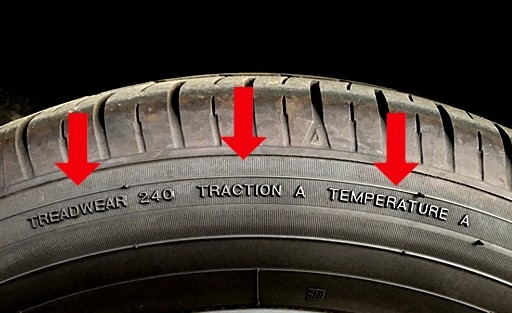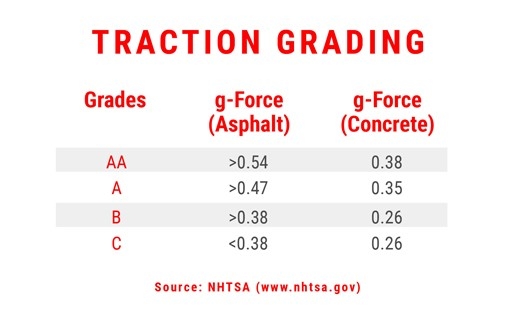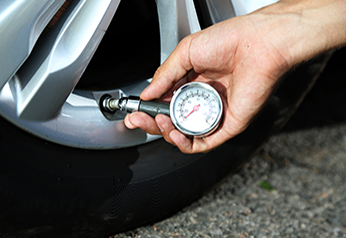
August 24, 2022
Your Complete Guide to UTQG Ratings
Manufacturers will spell out a tyre's specifications such as rim width, load rating, and speed rating via an alphanumeric codes engraved on your sidewall.
But aside from these, the United States government has also mandated manufacturers to include the Uniform Tire Quality Grade (UTQG) ratings on US-manufactured tyres.
What is UTQG, and how does this help you choose tyres? Tyroola gives you a complete guide to cracking the UTQG code.
Also read: Tyre Number Meanings Explained in Full

What is UTQG?
The Department of Transportation (DOT) and National Highway Traffic Safety Administration (NHTSA) created the Uniform Tire Quality Grade (UTQG) Ratings to help consumers make informed decisions when buying tyres.
Since 1979, US-made tyres on passenger vehicles such as cars, minivans, SUVs and light pickup trucks have included UTQG on their sidewall. These markings let you compare tyres on these three Ts:
• Treadwear
The treadwear grade is expressed as a number and gives you an idea of the tyre's life duration. Treadwear can range anywhere between 100 to 1000. Touring tyres, typically all-season and designed to provide a smooth, comfortable ride during long-distance drives, have high treadwear grades of 700 and above. Meanwhile, race car tyres have no tread to let them optimally grip dry roads, and as a result, they have low treadwear ratings.
How they measure it:
The tyre is measured against a control tyre with a treadwear grade of 100. Testers drive the tyres on a specific course that mimics public road conditions for nearly 11,500 kilometres. Every 1,200 kilometres, the tyres may be reinflated, rotated and aligned. At the end of the run, testers measure the tyre wear and compare it to the control tyre that went through the same process.
• Traction
In UTQG, traction is measured through the tyre's braking distances on wet concrete and asphalt. In general, traction is the resistance between the tyre and the surface, which lets your car roll forward. The stronger the tyre's wet traction, the greater the g-force it demands from interacting with the road to stop the car from skidding. Ratings are expressed in letter form, with AA being the highest and C as the lowest.

How they measure it:
With brakes locked, the tyres are pulled on a test vehicle at around 64 kilometres per hour. As the tyres slide on the wet asphalt and concrete, sensors measure their coefficient of friction.
Also read: 6 Wet Weather Driving Tips
• Temperature
The temperature grade is also expressed in letters, with A as the highest. The rating shows how efficient the tyre can resist or dissipate heat. With high heat tolerance comes a high speed rating and longer tyre life since heat build-up causes rubber deterioration, resulting in blowouts. All-season tyres are usually rated high in temperature resistance.

How they measure it:
Under controlled conditions in an indoor laboratory, the tyre is tested against a high-speed drum. As the tyre rolls, the drum's sensor performs multiple scans to measure heat resistance at varying speeds.
Also read: The Benefits of the EU Tyre Label When Buying Tyres
Is the UTQG accurate?

The UTQG may guide you in your purchase, but it's best not to rely on it solely due to these reasons:
• Limited Evaluation
Tyres are only tested for less than 12,000 kilometres to get their treadwear grade. Typically, tyres can last for about 40,000 kilometres. If tyres were tested for less than half of their maximum use, the results might not be accurate.
• Non-Standardised Testing
The NHTSA does not conduct treadwear testing; manufacturers outsource the testing or do it themselves. So, a 700 treadwear grade from a particular tyre company may not have the same quality as a 700 treadwear grade from another manufacturer.
• Narrow Definition of Traction
The traction grade doesn't include braking in dry conditions, cornering on wet roads, winter performance, and hydroplaning resistance. Moreover, most vehicles have anti-lock brakes that boost traction, helping drivers steer even when braking. This feature may affect traction ratings which are based on fully locked brakes.
• Required Only for Passenger Tyres
Not all tyres have the UTQG on their sidewalls. Those exempted from having these ratings are:
• Winter tyres
• Non-passenger tyres with a diameter of fewer than 12 inches
Also read: How to Choose the Right Tyres
How Do You Use the UTQG When Buying Tyres?
Despite its limitations, you can still use the UTQG when shopping for tyres. Here are some tips:
• Compare tyres from the same manufacturer.
Did you know that manufacturers can put a treadwear grade lower than the actual result? They are not allowed to over-report a tyre's treadwear rating but can under-report it, which some do for marketing purposes. This practice makes it impractical to compare treadwear across brands. But it will still make sense to use the treadwear score to compare products from the same manufacturer because the tyres most probably went through the same testing process.
• Set your expectations.
Before shopping, know what you want from your tyres. Do you value grip, durability, or excellent handling when speeding? If you're looking for an all-terrain tyre that can handle occasional rough drives, it's logical to look for a treadwear rating in the higher hundreds. A treadwear rating of 600 means it's projected to last six times longer than the test tyre.
• Consider the manufacturer's treadwear warranty.
If you want to gauge the tyre's mileage, look at the treadwear rating and the manufacturer warranty. Both figures will give you a good idea of how tough the tyre is. If the treadwear warranty is 50,000 kilometres, then you can expect to get at least that mileage from your tyres with proper maintenance. Additionally, a warranty ensures you can replace the tyre for free if it wears down faster than the defined period or mileage.
• Look beyond the ratings.
High scores in treadwear, traction and temperature resistance don't necessarily equate to a top-performing tyre. Remember that tyre health depends on factors such as proper inflation, regular maintenance, driving habits, and road conditions. If you want to get the most out of your tyres, do your part in caring for them.
Also read:Tyre Buying Guide: 8 Tips on How to Buy Tyres Online
Choose the Right Tyres for Your Car
Finding it challenging to compare tires? Tyroola makes it easier for you with brand comparisons and detailed descriptions of tyre models. Aside from product prices, most of our top, all-original tyres come with complete information on unique features, pros and cons, and independent reviews.
Shop for your tyres by entering your tyre size or rego, and take advantage of our cheapest prices online!
Craving more tyre tips? Visit our blog and guides.



